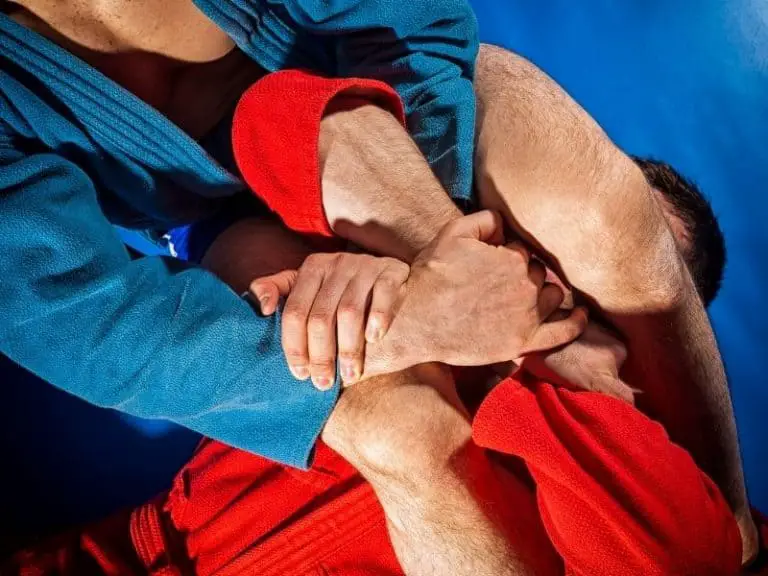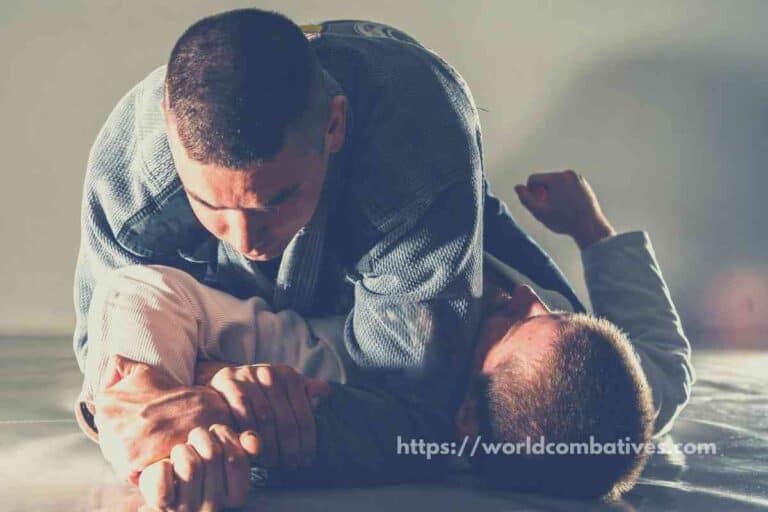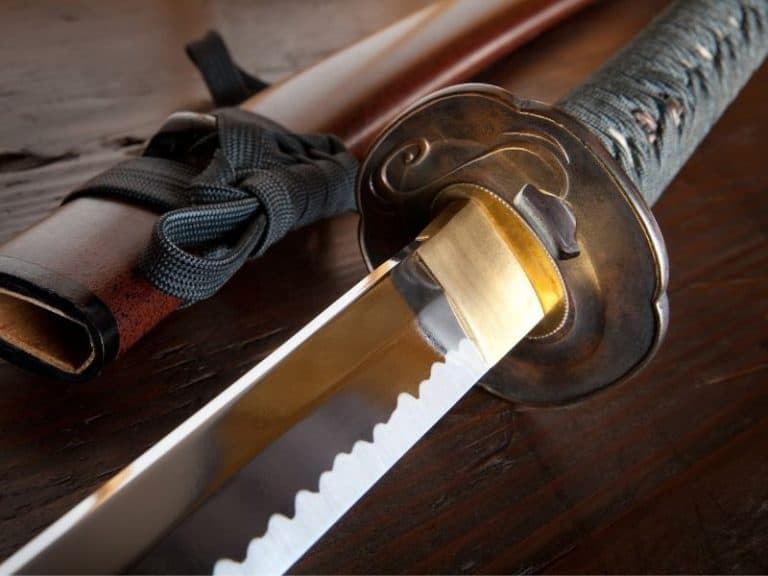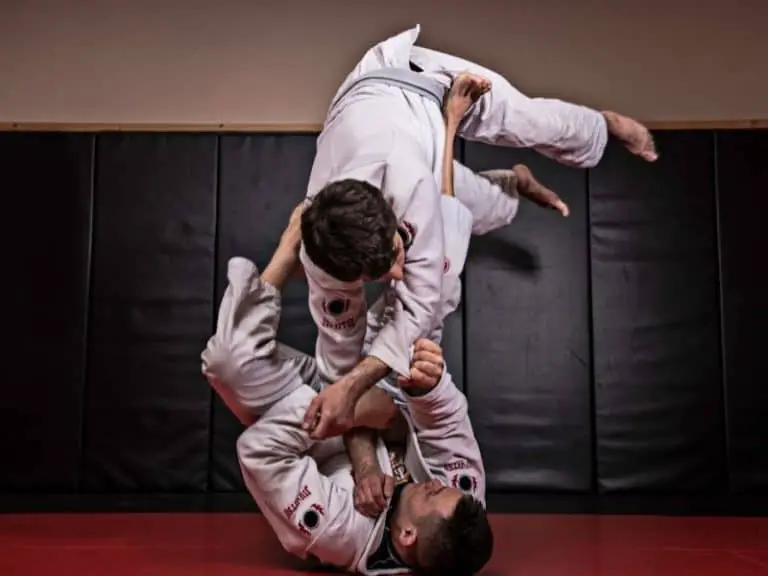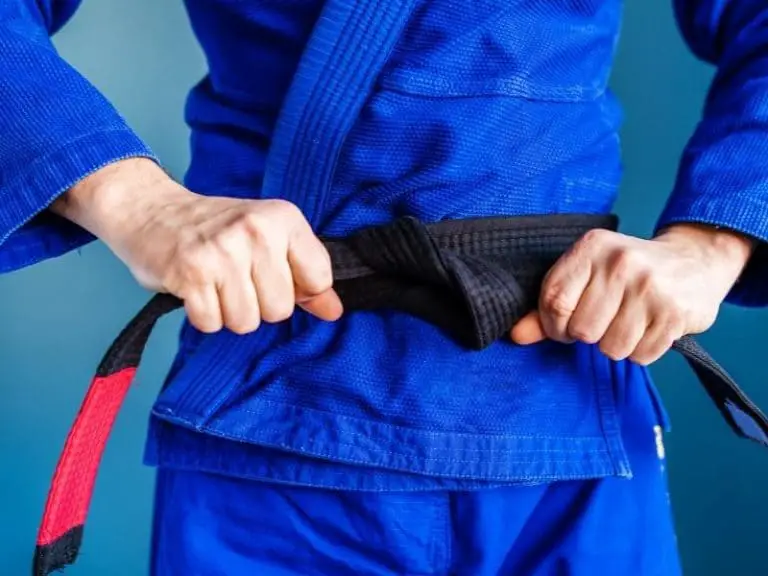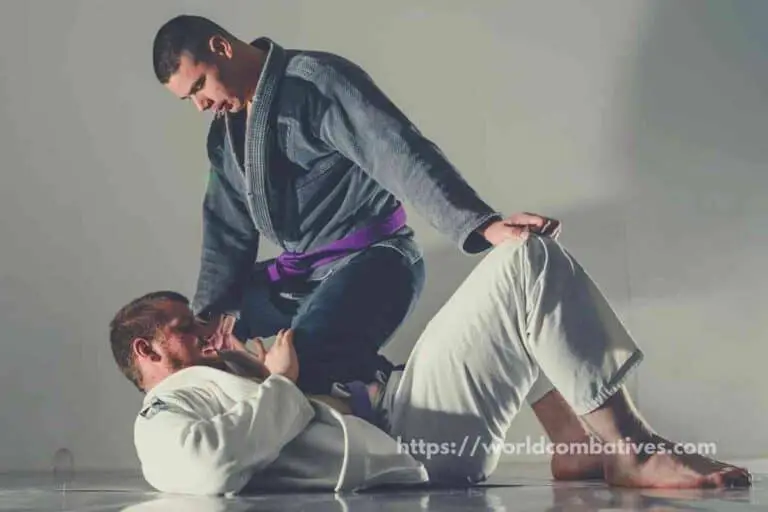Brazilian vs Traditional Jiu-Jitsu: EVERYTHING You Need to Know
I recently heard of Jiu Jitsu from a friend and I started searching around for information about them. I found out that there are two main branches of Jiu Jitsu, Brazilian and Traditional. I seek information about their history and difference so this article will about the difference between Brazilian and Japanese Jiu Jitsu.
As a general rule, Brazilian Jiu Jitsu focuses 90% on grappling and 10% throwing. Traditional on the other hand are more balanced. However, It also depends on the school of Brazilian Jiu Jutsu (BJJ) because some teaches more throwing and some don’t teach it at all. Furthermore, BJJ is more competition focused and Traditional Jiu Jitsu can be applied more in real life situations.
Their difference and how they came up is an interesting topic, it involved a lot about history and it is fascinating how times can change martial arts depending on the situation where it is needed. We will discuss them here.
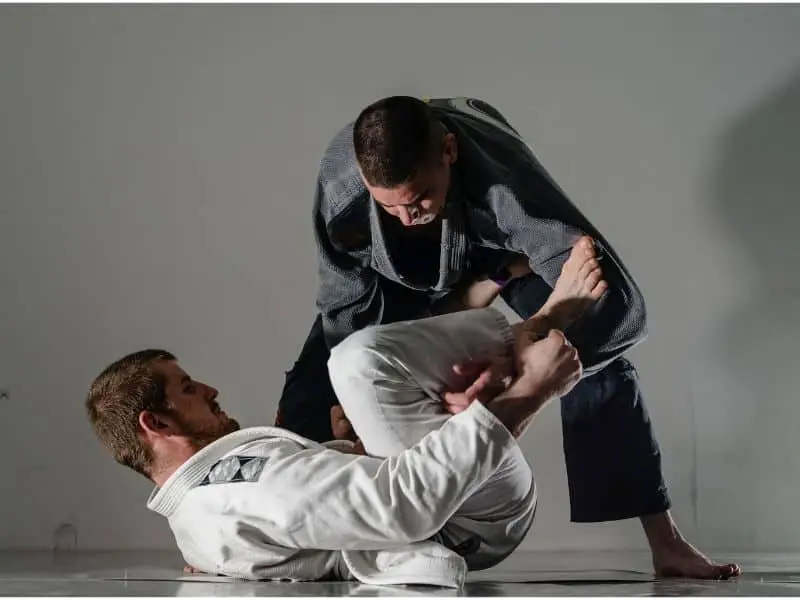
What is the difference between Brazilian Jiu Jitsu and Jiu Jitsu?
Brazilian Jiu Jitsu (BJJ) differs from Japanese or Traditional Jiu Jitsu by their moves. BJJ generally focuses on about 90% ground attacks and 10% throwing, while traditional is more balanced when it comes to ground attacks and throws. The environment also is a factor as Brazilian Jiu Jutsu is perfect for competition fights and Japanese Jiu Jitsu is perfect for real world scenario such as Street Fights.
Japanese Jiu Jitsu is said to be developed by monks as a peaceful method of self defense. This is made because Buddhist monks are mostly people who are un-armed and they need a form of self defense.
However, a martial arts that is perfect for an unarmed person is also a perfect self-defense for soldiers. That’s why it became a standard way of fighting or the chosen martial arts for samurai.
This is because it is a good martial art to use if a samurai loses his sword in a fight. This became a good way of self defense.
This is why in terms of street fighting, Traditional or the Japanese Jiu Jitsu is a very strong martial art. It has been the chosen self defense martial art for fighting. It is developed specifically for fighting.
There came where Jiu Jitsu was brought to Brazil where it was further developed. In Brazil, it was slowly changed into an art of ground fighting.
This is because of competition. Ground Fighting and making enemies give up is one of the most effective way in winning in a competition.
The power of the Brazilian Jiu Jitsu was made apparent on the 1993 UFC competition where Royce Gracie, the grandson of one of the pioneers of BJJ named Helio, defeated boxing, wrestling and savate in the competition.
After that, Brazilian Jiu Jitsu has been a famous martial art to learn especially in competitions. It might be the ultimate martial art made for competitions.
This is the reason why it is one of the best martial arts in competition.
However, it rarely or does not include strikes which is why Traditional is more suitable for all around self defense.
Which is better Brazilian Jiu Jitsu or Japanese Jiu Jitsu?
Brazilian Jiu Jitsu is better than Traditional Jiu Jitsu in a competition scenario. This is because the moves in BJJ is way competition focused, while Japanese Jiu Jitsu was developed for real life scenario. However, on real life scenario where self defense is really important, Japanese Jiu Jitsu will win because of its variety of throws unlike BJJ which is focused on ground fighting .
This is because of how it is made.
Brazilian Jiu Jitsu is better than Japanese Jiu Jitsu in competition scenarios. This is because it is focused on grappling and ground movements.
This makes opponents give up as fast as possible, thus BJJ wins the competition.
However, Brazilian Jiu Jitsu is not made for real life defense.
Traditional or Japanese Jiu Jitsu is made for soldiers particularly samurai warriors to fight if they lost their weapon. That’s why it is a complete martial art for street fight that involves not just grappling and ground attack but also throwing and striking.
It is a complete package for street fights and that’s the difference of Traditional Jiu Jutsu from Brazilian.
Brazilian will win in a competition scenario because it is specialized to do so. While traditional have much more variety of moves, Brazilian will win because of its specialization.
However, in real life self defense scenario especially if you are unarmed, traditional Jiu jitsu is a perfect martial art since it is more well-rounded.
Is all Jiu Jitsu Brazilian?
Not all Jiu Jitsu is Brazilian. Brazilian Jiu Jitsu came from Japanese Jiu Jitsu which is the Traditional Jiu Jitsu and has been around for thousands of years. Furthermore, another branch out from Traditional Jiu Jitsu is Judo which focuses on throws and less grappling compared to BJJ.
While Brazilian Jiu Jitsu became really famous because of UFC, Jiu Jutsu is not all Brazilian.
Brazilian Jiu Jutsu branched out from Traditional Jiu Jutsu which is a well rounded martial arts used by Samurai warriors as a form of self defense,
As the need for ground fighting and joint locking for competition arises, the specific part of Traditional or Japanese Jiu Jitsu which are the grappling techniques became more effective.
With the specialization of those grappling and joint locking techniques come another branch of Jiu Jitsu which is Brazilian Jiu Jitsu.
So in summary, not all Jiu Jitsu is Brazilian. In fact, the Traditional version is Japanese.
Furthermore, there is another which is quite the opposite of Brazilian Jiu Jitsu which focuses on throwing and putting enemies imbalanced. It is called Judo.
So both Judo and Brazilian Jiu Jutsu are specialized forms of Traditional Jiu Jitsu.
What is Brazilian Jiu Jitsu
Brazilian Jiu Jitsu is a modern martial art that branched out from the Traditional Jiu Jitsu. It focuses on ground attacks, grappling, and joint locks. Thus, it is one of the most effective martial art people use in competitions. It became famous on a UFC fight in 1993 where BJJ showed its strength when Royce Gracie defeated 3 martial arts in the competition.
That is the start of Brazilian Jiu Jutsu becoming famous. Since then, it was used by various martial artists and became very popular worldwide.
This is because Brazilian Jiu Jitsu is specialized on joint locks, grappling, and giving pain to enemies.
This pain causes them to give up and it doesn’t require a lot of energy to do so.
Remember that orignally, this is made by unarmed monks.
It is a good fighting style because it is based on efficiency on competition points.
You will see people using this fighting style while fighting with each other on ground until someone gets locked and give up.
What is Japanese Jiu Jitsu
Japanese Jiu Jitsu is one of the oldest martial art available today with over a millennia in age. This is why it is also called Traditional Jiu Jitsu. It is a well balanced martial art that focuses on choking, striking, strangling, throwing and blocking. It is a good martial art in self defense scenario because it was once used as a self defense for samurai warriors whenever they lost their sword in fight.
Japanese Jiu Jitsu has made a long way and it has been around in our age. Even if it has aged for a millennia. This is because of its effectiveness.
It is a very powerful and well balanced technique that doesn’t require weapons to be very powerful. It is good for self defence since most of the time even if you will fight without weapons.
Its effectiveness was proven during the samurai era which it became a standard way of their fighting.
Samurai were able to fight effectively even without their swords making them a strong group of soldiers.
Thus, its effectiveness is what bring them up to us today. While Brazilian Jiu Jitsu might be very famous and might be more famous right now, it came from this martial art.
If you are looking for a martial art good for self defense especially on street fights, Japanese Jiu Jitsu is a good choice.
Summary
There has been lots of discussions, but there are lots of things Japanese or Traditional Jiu Jitsu are different from Brazilian Jiu Jitsu. So to make it easy to understand, here is a table summary of everything you need to know about their differences.
| Japanese/ Traditional Jiu Jitsu | Brazilian Jiu Jitsu | |
| Purpose | General Purpose | Competition |
| History | Used by Samurai Warriors | Used for Locking in Competitions |
| Moves | Balanced of Strikes, Ground and Throws | Focused on Ground attacks |
| Rules | Few Competition Matches with Different Rules | Rules are almost identical to all types of competition |
| Belts | 8 Belts | 8 Belts |
| Highest Belt | Black Belt | Red Belt |
| Mastery | 2-3 years | 10-15 years |
| Training | Warm-Up, Exercises, Striking, Blocking, Breakfall Training, Sparring, Cool Down | Warm-up, Drills, Sparring, Cool Down |
| Cost | $50 – $100 per month | $150 – $200 per month |
| Popularity | Asia, South America | USA, Canada, Europe, Australia |
| Actual Fights | Can take more than 1 enemies easily because of the Inclusion of Strikes | Good for one versus one situation |
| Injuries | More prone to injury because of strikes and throws | Ground fights tend to produce less injury but still possible |
| Competitions | Rare to None | Many Competition Opportunities |
Purpose of Doing: Traditional vs Brazilian Jiu Jitsu
In general, Traditional Jiu Jitsu is more general purpose. It can be used in competitions, matches and even actual street fights.
Though, you need to keep in mind that participating in Street fights are usually against the rules in any martial art.
But Traditional is a general purpose and a good self defense martial art.
Brazilian Jiu Jitsu on the other hand is perfect to use in competitions. That’s why a lot of top MMA fighter have a Black belt in Brazilian Jiu Jitsu.
History of the Martial Art: Traditional vs Brazilian Jiu Jitsu
Traditional Jiu Jitsu is powerful on actual fight as it was used by samurai warriors whenever they are in a disadvantage such as losing their sword. This is different from Brazilian Jiu Jitsu that is made to dominate competitions.
The power of Jiu Jitsu shined through people when Royce Gracie defeated 3 martial arts in the competition using the martial art.
The Difference in Terms of Moves of Traditional vs Brazilian Jiu Jitsu
Traditional is well balanced with a variety of ground attacks, locks, strikes and throws.
Brazilian Jiu Jitsu is specialized in ground attacks such as locks and chokes. Though some schools teach a little strikes, some schools just teach ground attacks.
You can check the article on striking in Brazilian Jiu Jitsu if you are interested: Is striking such as punching and kicking allowed in Brazilian Jiu Jitsu?
Variation of Rules in Traditional vs Brazilian Jiu Jitsu
Traditional Jiu Jitsu is not competition based. Thus, its rules are quite different from each other on matches. There is Ju-Jitsu International Federation (JJIF) and they host 3 events for Traditional Jiu Jitsu.
Brazilian Jiu Jitsu on the other hand have a general set of rules which are more uniform compared to Traditional Jiu Jitsu.
The Belts in Japanese Jiu Jitsu and Brazilian Jiu Jitsu
While both of them comprise of 8 belts, the color arrangement are different. Here are their difference.
Traditional Jiu Jitsu Belt Progression
- White
- Yellow
- Orange
- Green
- Blue
- Purple
- Brown
- Black
Brazilian Jiu Jitsu Belt Progression
- White
- Blue
- Purple
- Brown
- Black
- Red and black belt
- Red and white belt
- Red belt
How many years to reach Black Belt in Japanese Jiu Jitsu and Brazilian Jiu Jitsu
A talented and dedicated individual training a lot can reach a black belt in Brazilian Jiu Jitsu in 8 years. However, most if not all will take 10-15 years. Japanese Jiu Jitsu on the other hand can only take 2-3 years to reach black belt.
Difference in Training Between Japanese and Brazilian Jiu Jitsu
Japanese Jiu Jitsu Training is well balanced with Warm-Up such as stretching, Exercises, Striking, Blocking, Breakfall Training, Sparring and Cool Down
While Brazilian Jiu Jitsu is more focused on Sparring matches with classes usually having arm-up, Drills, Sparring and Cool Down
Cost of Classes in Brazilian vs Japanese Jiu Jitsu
Japanese Jiu Jitsu Classes tend to be cheaper compared to Brazilian Jiu Jitsu with Traditional Jiu Jitsu costing around 50 to 100 dollars per month compared to Brazilian Jiu Jitsu classes that costs around 150 – 200 dollars per month.
The difference in price is dependent on the school you will be attending.
Popularity Difference Between Brazilian and Japanese Jiu Jitsu
Traditional Jiu Jitsu is more popular in Asia and South America, while Brazilian Jiu Jitsu is popular in USA, Canada, Europe and Australia.
Overall, Brazilian Jiu Jitsu is more popular than Japanese Jiu Jitsu because of its focus on competitions.
Here is a photo showing their difference in popularity worldwide
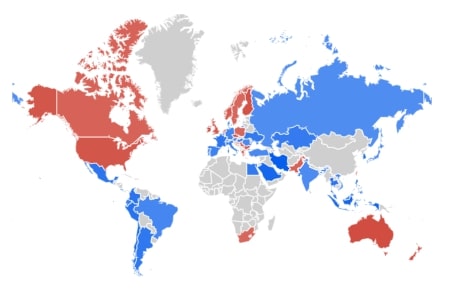
Which is Better in Actual Fight, Japanese or Brazilian Jiu Jitsu?
In an actual fight of one versus one, Brazilian Jiu Jitsu is better because it is heavily focused in immobilizing enemy attacks. But because of this grapple involved in Brazilian Jiu Jitsu, it leaves them vulnerable to other attackers making them weak if not on a 1 versus 1 situation.
Japanese Jiu Jitsu is better when fighting against multiple enemies in an actual fight. This is because they have strikes and throws which really helps if he or she is outnumbered.
So in actual fight, traditional wins.
But if you are asking on a one versus one between Brazilian and Traditional Jiu Jitsu, Brazilian Jiu Jitsu will most likely win because it is designed for a 1 versus 1 situation.
But on real fights especially when outnumbered, Japanese Jiu Jitsu wins.
Which is more prone to Injuries: Japanese or Brazilian Jiu Jitsu?
Training in Japanese Jiu Jitsu is more prone to injuries. This is because this sport involves a lot of throws and strikes which is hard for the body.
Brazilian Jiu Jitsu on the other hand are focused on ground fights which can still cause injury but less likely compared to throws.
If you are interested in my recommended starting gear, here is my article discussing them. It is made so that older people who want to start learning Jiu Jitsu will prevent injuries, but if you are still young, my recommendations will still be the same: Are you old to start Jiu Jitsu?
Which has more Competition Opportunities: Traditional vs Brazilian Jiu Jitsu
Brazilian Jiu Jitsu has more competition opportunities compared to Traditional Jiu Jitsu. This is because they are more competition focused. Thus, they have multiple organizations that hosts these events.
The organizations who host Brazilian Jiu Jitsu competitions are:
- International Brazilian Jiu-Jitsu Federation (IBJJF)
- ADCC
- North American Grappling Association
- United Arab Emirates Jiu Jitsu Federation (UAEJJF)
- Jiu Jitsu World League (JJWL)
- Sport Jiu-Jitsu International Federation (SJJIF)
- Grappling Industries
While for Japanese Jiu Jitsu we have Ju-Jitsu International Federation (JJIF).
There you have it, I have listed their differences in a comprehensive way in this post, I hope you got something to look forward.

worldcombatives.com is reader-supported. When you buy through links on the site, I earn an affiliate commission.
Welcome to my recommended list of Jiu-Jitsu gear.
In this section, you are going to see my recommended Jiu-Jitsu gears both for beginners and pros.
Grappling Shorts
When getting some grappling shorts, you first need to understand that the thing we are looking for in grappling shorts is the ones that will provide flexibility.
This means that we are not looking at designs but what we are looking for is how comfortable it is and if you can do a full range of motions while wearing the shorts.
If that’s the case, I recommend an IBJJF approved grappling short which has no pockets that can interfere with rolls, and most importantly, allows a full range of motion. This can help you in rolls since you need to have fluid motions to do some maneuvers.
Here is the link for the product: BJJ Shorts
Grappling Spats
Grappling spats are a great alternative to Grappling shorts and are sometimes used in conjunction with Grappling shorts.
The reason for using a Grappling spat is to prevent friction.
Remember that BJJ is focused on rolls, locks, and takedowns. This is prone to friction that can cause injuries such as burns and mat cuts.
In choosing a good pair of grappling spats, you need to take note that it is important that it is also flexible so you can easily do some full-range motions while rolling.
Furthermore, since you will be covering your whole legs with it, it is important for it to absorb some sweat while still being comfortable for the wearer.
If that’s the case, I recommend these Grappling Spats which are very stretchable making them good for fluid motion. Furthermore, it is well made to handle friction which prevents any unwanted injuries.
Lastly, its cloth is breathable which means that it is very comfortable for your skin.
Here is the link for the product: Grappling Spats
Rashguard
Think of a rash guard as the grappling spat for the upper body.
Rashguard helps in preventing friction that can cause injuries such as mat cuts and burns.
When finding one, it is important to find a comfortable rash guard which is breathable. Furthermore, have one that allows a full range of motion.
Thus, I recommend this rash guard which does all of the functions I’ve said: Rashguard
Knee and Elbow Pads
Personally, I am a victim of a knee injury. That’s why I always tell people to use knee and elbow pads when doing some physically intensive activities such as BJJ.
Because of my injuries, I can’t really last long with any sort of long physical activity.
So, while it is often neglected, I believe that Knee and Elbox pads are important.
Good Knee and Elbow pads are supposed to be comfortable while still providing maximum protection to both your elbows and knees.
Thus, I recommend these safety gears:
Ear Protectors
There are lots of cauliflower ear incidents with BJJ practitioners.
Even if this is quite an unpopular safety gear, it is important as we are preventing friction that can come from rolls.
In choosing an ear protector, you do not need to get something that protects you from strikes. Striking is usually not allowed.
So, what’s important is to find something that is very lightweight and protects you from friction.
If that’s the case, then you may opt for this which is really useful and won’t look weird on rolls: Ear Guards

